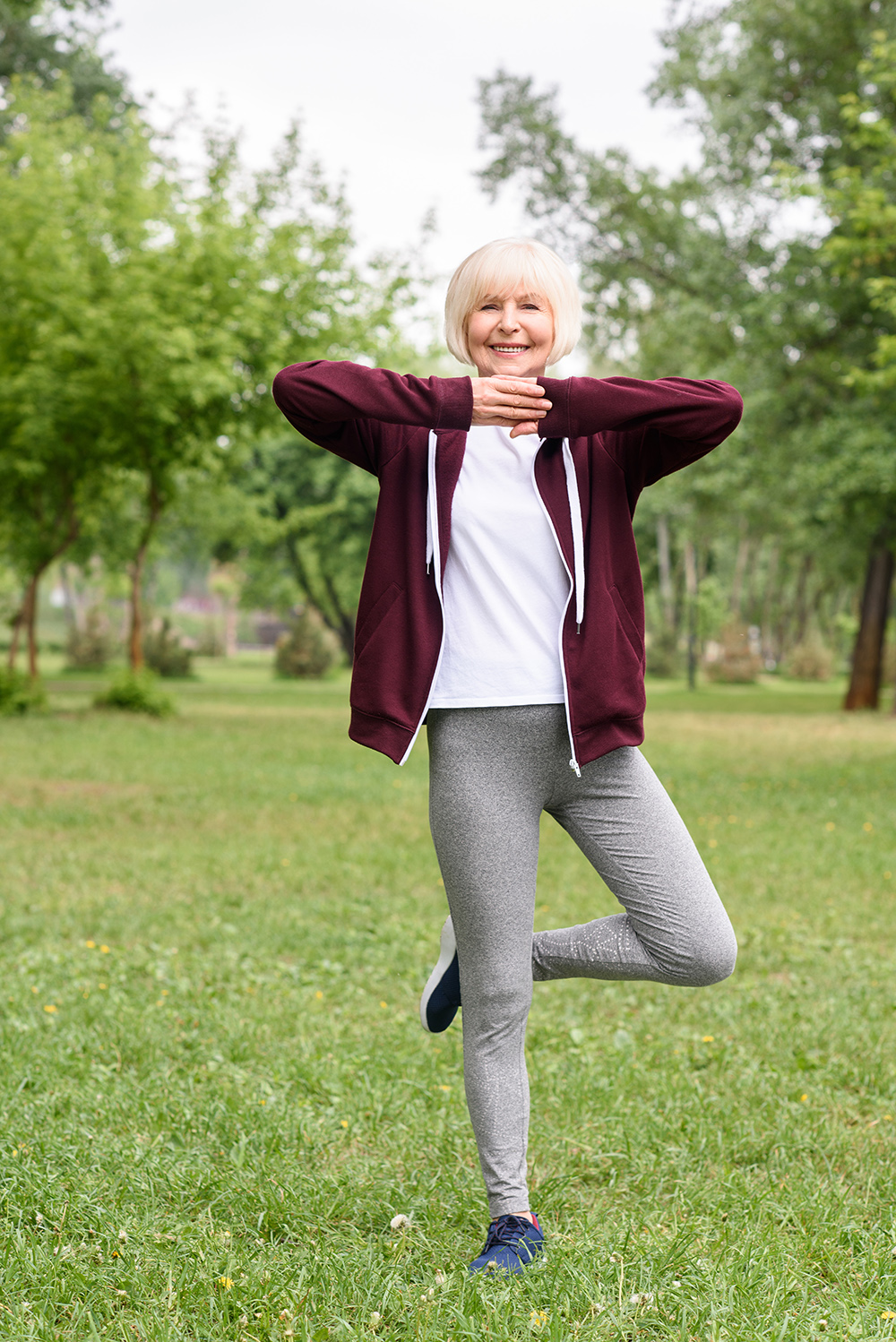When we are young we take our balance and coordination for granted. Yet as we progress through the years sometimes our muscles get weaker and joints get tighter and our posture changes all contributing to decreases in balance skills.

Everybody knows to stay fit a person needs to engage in cardiovascular exercise, stretch what is tight and strengthening what is lax. But too often people miss an important aspect that is critical for functional fitness, which functional balance. The ability to maintain balance is a very complex skill that requires a vast array of systems to interact simultaneously. Even the basic activity of walking involves a complex sequence of neurological and muscular interactions.
Functional Balance is critical for everyone from the world-class skier to the wounded warrior trying to regain his or her ability to walk again. Functional balance is a combination of both static and dynamic balance. These two parts of balance are critical for maintaining an independent and fully functional life! It is easy to see how the loss of functional balance can inhibit even the simplest activities of daily living, to a person’s involvement in recreational sports.
Many common chronic conditions from arthritis to neurological issues can influence a person’s ability to maintain proper balance. Some research published in the Archives of Physical Medicine and Rehabilitation 2015 discussed that person’s with Osteoarthritis and Rheumatoid had better mobility, and more stability after participation in a balance training program. Person’s with Ankylosing Spondylitis had improved quality of life after a seven months of balance training. Another study found that individuals with Fibromyalgia had less falls after 6 weeks of balance training.
What is balance?
Balance is defined as “the ability to maintain the center of a mass over the base of support”. This is evident even when you see rocks strategically placed on top of each other to produce sculptures.
Types of Balance
Static balance means remaining stationary in one place for a period of time. A common balance assessment to measure static balance is to stand on one foot for a period of time. A functional example of static balance is standing on your tiptoes while reaching for something without losing one’s balance
Dynamic balance is when the body is able to maintain in a state of balance while in motion or transition. Functional examples are being able to move effortlessly and gracefully from one place to the next at any given speed, or to be able to change direction quickly while still maintaining balance. Dynamic balance is critical for performance in most sports but is underappreciated until deficits set in sometimes seen in aging or in chronic health condition.
Extrinsic & Intrinsic Factors that Influence Balance
The occurrences of Chronic Conditions are often classified as “intrinsic” factors influencing the likely hood of diminished balance. Many common chronic conditions from arthritis to neurological issues to sensory losses can impair balance.
Extrinsic Factors come in all shapes and sizes. Many extrinsic factors that contribute to falls are preventable. The following is a list of things that are commonly listed reasons people fall and visit the ER. These can occur no matter what your age or fitness level.
Home Hazards
Loose carpets, slippery rugs, ill-fitted slippers, things left on the floor, clutter, reaching for objects, poor lighting, bathroom showers and tubs.
Outdoor Hazards
Wet/icy surfaces, uneven surfaces, hurrying, climbing ladders and wearing inappropriate shoes.
Effects of Medication
Many medications/drugs interfere with balance. Whether the medication is prescribed or is an over-the-counter medication it can still have a deleterious effect upon a person’s balance and coordination. Taking more than four medications increases a person’s risk of falling. Also, it has been found that older clients (65yrs and over) cannot tolerate medications the same way a younger person can. It also goes without saying that alcohol; marijuana and other recreational drugs can impair balance and coordination.
Other Factors that Influence Stability

COG = center of gravity
Base of Support = the wider the base of support the better the stability of the person.
Friction = often called the glue/traction between the surface and the supporting platform.
Supporting systems = having enough strength to support the person. Thus the use of a cane, crutches and walkers are examples of aides to improve the supporting system.
More and more research supports the incorporation of balance training in a comprehensive fitness program.
Six Steps to Better Balance
- Avoid Disuse, which will cause atrophy. Use it or lose it! If flexibility and muscle development are not done on an on-going basis, the strength and flexibility will be lost! Maintain adequate strength and flexibility in joints and muscles.
- Keep core muscles firm.
- Maintain good lower leg and ankle strength and flexibility.
- Practice proper posture and head placement.
- If you suspect a deficient in the sensory, visual or neurological systems seek medical attention. No amount of balance training will help if a dysfunction exists.
- What you do today determines your tomorrows. Practice balance work daily. Some people practice while brushing their teeth or walking to work.
Balance Assessment
- Stork Stand. Can the client stand on 1 leg for 30-60 seconds without wobbling all around?
- Can the client get up and down from a chair in 30 seconds?
- If under 40 years of age, over 15-20 times = good
- If over 60 years of age, over 10-12 times = good
- Sit to stand and walk 10 feet and turn around and return to your seat.
Summary
One thing is for sure when it comes to balance, change will occur! Diminishes in balance range from a simple embarrassing slip to a major fall leading hospitalization. It is up to the person whether the change is positive or negative. The good news is balance can be maintained and often improved at any age or condition. It is never too late to make positive contributions to better balance.
For more specific information and exercise protocols from Dr. Knopf, check out his book, Stability Workouts on the Balance Board
You can also read some of our other articles on the topic, 4 Exercises to Increase Balance for Seniors and Strategies to Improve Your Balance and Stability
Karl Knopf, Ed.D, was the Director of The Fitness Therapy Program at Foothill College for almost 40 years. He has worked in almost every aspect of the industry from personal trainer and therapist to consultant to major Universities such as Stanford, Univ. of North Carolina, and the Univ. of California well as the State of California and numerous professional organizations. Dr. Knopf was the President and Founder of Fitness Educators Of Older Adults for 15 years. Currently, he is the director of ISSA’s Fitness Therapy and Senior Fitness Programs and writer. Dr. Knopf has authored numerous articles, and written more than 17 books including topics on Water Exercise, Weights for 50 Plus to Fitness Therapy.

